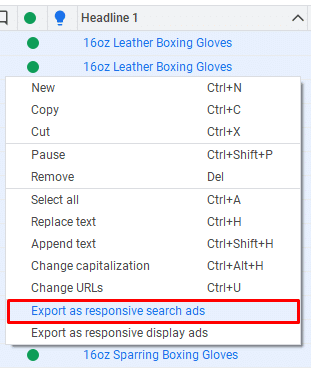Responsive Search Ads (RSAs) have been the default Search ad type in standard campaigns for a year, but you’ve been able to still add Expanded Text Ads (ETAs) to your account. But all good things come to an end, and Google’s planned sunsetting of ETAs in Search campaigns is in a little more than three months.
According to Google, “After June 30, 2022, you’ll no longer be able to create or edit expanded text ads. However, your existing expanded text ads will continue to serve alongside responsive search ads, and you’ll still see reports on their performance going forward. Additionally, you’ll be able to pause and resume your expanded text ads or remove them if needed.”
If you haven’t started adding RSAs to your account, here are six helpful tips to get you started.

1. Repurpose high-performing content from your ETAs and focus on Ad Strength.
Pull your ad copy from ETAs that have already been performing well, and turn them into RSAs by incorporating more headlines and descriptions. You will need to use Google Editor to export your ads.
a) Highlight the ETAs you want to convert into RSAs.
b) Right-click and select “Export as responsive search ads.”
c) Make your changes in the .csv file that downloads.
d) Upload your new RSAs.
2. Think strategically about your headlines and descriptions.
Best practices from Google include taking advantage of all the headlines allotted and using the descriptions to enhance the message. JumpFly has been using at least two custom-tailored headlines based on the Ad Group, and the remaining 12 to 13 headlines have relevant company information (ex: company name, award or testimonial information, free shipping, etc). It’s also important to note that the descriptions should be unique and not redundant, as Google may place two similar descriptions together during its automation.
3. Check your account’s Recommendations page.
The Recommendations page within the Google Interface can be very helpful in quickly and efficiently adding and improving RSAs where you need them. It will show you where you need to add RSAs and give you suggestions for improving existing RSAs ad strength with potential new headlines and descriptions based on ad copy from your account.
4. Be cautious about pinning headlines or descriptions to specific positions in your responsive search ads.
Google believes this to be helpful if you want certain messaging to be shown every time, such as making sure that specific promotion information or legally-required information is shown. However, we’ve found that pinning takes away from the machine-learning process and can negatively impact performance. JumpFly’s best practice for RSAs is no pinning so that automation can try any and all combinations that bring better results.
5. Use ad variations.
Google has said that different versions of ads can help test for whichever version performs better. We tend to do this when we have a promotion running or when we’re testing completely different messaging. We’ll have an evergreen ad – meaning one with consistent messaging that doesn’t change with a sale, season, etc, and then a second RSA that highlights the sale, promotion, or seasonality. This is also important because you can enable or pause an ad when a sale starts or stops; there’s no ability to enable or pause specific headlines or descriptions of an RSA.
6. Evaluate the success of your ads based on incremental impressions, clicks, and conversions your ad groups and campaigns receive.
RSAs help to show your ads to a wider net of relevant auctions because they are adapting their message to the search query. When advertisers switch from ETAs to RSAs using the same assets, there is an average increase of 7% more conversions at a similar cost per conversion. You should be tracking any improvements in your accounts so that you can see what is performing better and what might not be so that you can make the necessary adjustments.
Google is combining creativity with the power of machine learning to help show more relevant ads to more people and optimize ad performance. This change reflects Google’s plan to move more towards automation in standard Search campaigns and will allow advertisers to spend more time focusing on strategic planning for their businesses.








